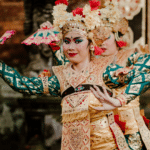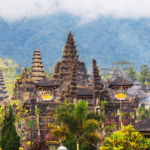Lempuyang Temple’s Gate of Heaven, known as Pura Lempuyang Luhur, is one of Bali’s oldest and most revered places of worship. Situated in the highlands of Mount Lempuyang in East Bali, this temple is not only a site of spiritual significance but also a testament to Balinese culture and architectural prowess. The journey to Lempuyang Temple and the exploration of its grounds offer an immersive experience into the heart of Balinese tradition and natural beauty.
The Journey to Lempuyang Temple
The trip to Lempuyang Temple is an adventure in itself. Located approximately 90 kilometers from Denpasar, the temple sits at an elevation of 1,175 meters above sea level. The drive takes you through the picturesque landscapes of Bali, with its terraced rice fields, lush forests, and rural villages, offering a glimpse into the everyday life of the Balinese people.
As you approach the temple, the road ascends through a series of winding, scenic routes. The air gets cooler, and the vegetation more lush, indicating your arrival in the highlands of East Bali. The journey requires a bit of effort, but it’s this seclusion and tranquility that adds to the temple’s mystical allure.
Arriving at the Temple
Upon arrival, visitors are often struck by the serene and sacred atmosphere that envelops Lempuyang Temple. The temple complex is made up of seven different temple compounds, but the most iconic and photographed part is the Penataran Agung Lempuyang. This main temple features the famous “Gate of Heaven,” a split gateway that perfectly frames Mount Agung, Bali’s largest and most sacred volcano.
The architecture of the gateway is a fine example of Balinese design, adorned with intricate carvings that depict various mythological and spiritual themes. The gate, with its towering height and majestic posture, symbolizes the cosmic mountain, Mount Meru, which is considered the center of all the spiritual and physical universes in Hindu cosmology.
The Symbolism of the Gate of Heaven
The “Gate of Heaven” at Lempuyang Temple holds profound spiritual significance. It represents the boundary between the material world and the spiritual realm. In Balinese Hinduism, it is believed that passing through this gate symbolizes purification of the mind and soul, a transition from the mundane to the sacred.
The view from the gate is nothing short of spectacular. On clear days, Mount Agung looms majestically in the background, creating a postcard-perfect scene. This view not only offers a moment of awe but also a chance for introspection and spiritual contemplation.
Exploring the Temple Grounds
The temple grounds extend beyond the Gate of Heaven, with several other pavilions and areas to explore. As you venture further, you’ll encounter various shrines, each dedicated to different gods and manifestations of Shiva. The temple’s architecture is a reflection of Balinese Hinduism, which is a unique blend of Hindu, Buddhist, and indigenous beliefs.
The higher you climb, the more panoramic the views become. The journey through the temple’s compounds is a form of spiritual ascension, bringing you closer to the divine. Each level of the temple offers a different perspective, both visually and spiritually.
The Cultural and Religious Significance
Lempuyang Temple is not just a tourist attraction but a living, breathing place of worship. It plays a crucial role in the religious life of the Balinese Hindu community. Throughout the year, the temple is a site for various ceremonies and pilgrimages, where devotees come to offer prayers, perform rituals, and seek blessings.
Visitors to the temple are expected to dress respectfully, covering shoulders and legs. Sarongs and sashes are available for rent at the entrance. This respect for local customs and traditions is paramount to maintaining the sanctity of the temple.
A Testament to Balinese Art and Craftsmanship
The temple’s structures are a showcase of Balinese artistry. The carvings, sculptures, and gates are all handcrafted by local artisans, following centuries-old techniques. These works of art are not just decorations but are imbued with symbolic meanings and stories from Hindu mythology.
The Natural Surroundings
The natural beauty surrounding Lempuyang Temple adds to its mystical charm. The lush greenery, the sounds of nature, and the cool mountain air create a tranquil and refreshing environment. This connection with nature is an integral part of the temple’s allure, offering a peaceful retreat from the hustle and bustle of modern life.
In Conclusion
Visiting Lempuyang Temple is more than just a tourist activity; it’s an opportunity to experience the cultural, spiritual, and natural wonders of Bali. The journey to the temple, the ascent through its compounds, and the awe-inspiring views all contribute to a memorable and enriching experience. Whether you’re seeking spiritual insight, cultural immersion, or simply the beauty of nature, Lempuyang Temple’s Gate of Heaven is a destination that truly encaps
Frequently Asked Questions about Gate of Heaven Lempuyang Temple
1. What is the Gate of Heaven Lempuyang Temple?
The Gate of Heaven at Lempuyang Temple is a highly revered and picturesque spot in Bali, Indonesia. It’s known for its stunning split gate that frames Mount Agung, offering a breathtaking view and a deeply spiritual atmosphere.
2. Where is Lempuyang Temple located?
Lempuyang Temple is situated in eastern Bali, Indonesia, on Mount Lempuyang. It’s approximately a 2-hour drive from popular areas like Kuta and Ubud.
3. What is the best time to visit the Gate of Heaven?
The best time to visit is early in the morning, ideally at sunrise. This not only helps avoid the crowds but also increases the chance of a clear view of Mount Agung without clouds.
4. Is there an entrance fee?
There is no fixed entrance fee, but a donation is expected at the temple gate. The amount is discretionary, and it contributes to the temple’s maintenance.
5. Are there any dress code requirements?
Yes, visitors are required to wear a sarong and a sash, which can be rented at the entrance. Proper attire is necessary to respect the temple’s religious significance.
6. How challenging is the climb to the temple?
The climb to the main gate is not very strenuous, but it involves a series of steps. Visitors should be in good physical condition and wear comfortable shoes.
7. Can I take photographs at the temple?
Yes, photography is allowed, and the Gate of Heaven is particularly popular for its photogenic view. However, it’s important to be respectful and avoid disrupting any religious activities.
8. Are there any facilities available at the temple?
Basic facilities like restrooms and small stalls selling refreshments and souvenirs are available. However, options are limited, so it’s advisable to bring water and any necessary items with you.
9. How long does a visit typically take?
A visit to Lempuyang Temple can take anywhere from 1 to 3 hours, depending on how much time you spend exploring and taking photographs.
10. Is it necessary to hire a guide?
While it’s not mandatory to have a guide, hiring one can enrich your visit with insights into the temple’s history, culture, and religious practices.











